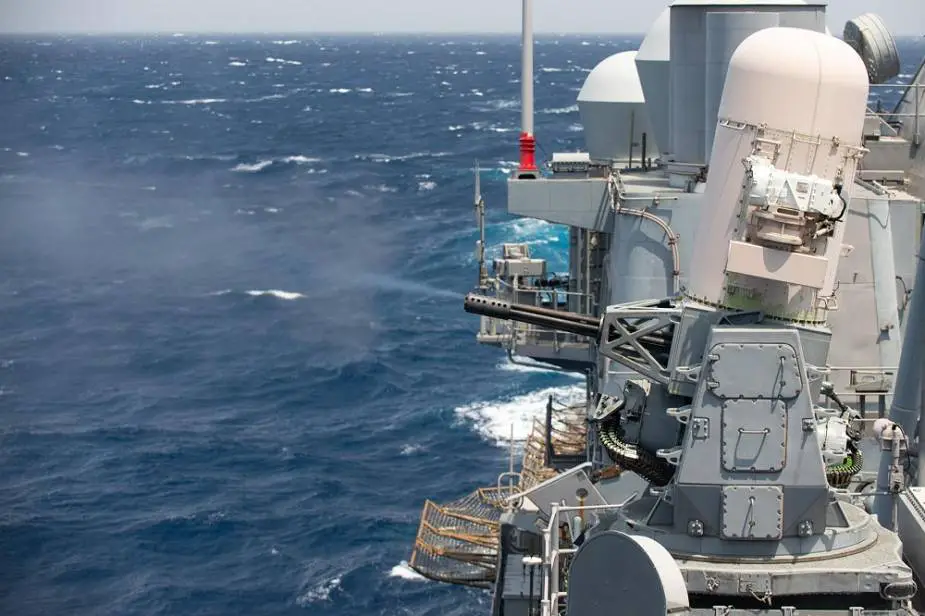On June 22, 2020, the Australian Minister of Defence has announced that the Royal Australian Navy’s latest upgrade of the Mark 15 Phalanx Close-in Weapon System (CIWS) has reached a major milestone by achieving Initial Operating Capability. Delivered on schedule, the upgraded capability is being progressively rolled out until late 2023 across Navy’s Destroyers, Amphibious Ships and new Supply Class Tankers.
On June 22, 2020, the Australian Minister of Defence has announced that the Royal Australian Navy’s latest upgrade of the Mark 15 Phalanx Close-in Weapon System (CIWS) has reached a major milestone by achieving Initial Operating Capability. Delivered on schedule, the upgraded capability is being progressively rolled out until late 2023 across Navy’s Destroyers, Amphibious Ships and new Supply Class Tankers.
Follow Navy Recognition on Google News at this link
 The Ticonderoga-class guided missile-cruiser USS Bunker Hill (CG 52) fires its Phalanx close-in weapons system during a live-fire exercise March 16, 2020. (Picture source U.S. Navy)
The Ticonderoga-class guided missile-cruiser USS Bunker Hill (CG 52) fires its Phalanx close-in weapons system during a live-fire exercise March 16, 2020. (Picture source U.S. Navy)
Australian Minister for Defence, Senator the Hon Linda Reynolds CSC said the upgraded system delivers improved lethality and a broader range of protection for Navy ships in fast-moving combat situations.
“The first system, which incorporates the upgrade to Block 1B Baseline 2 of the Phalanx system, has already been installed into HMAS Sydney which will ensure she enters service as Australia’s most potent and capable warship,” Minister Reynolds said.
“The system significantly boosts HMAS Sydney’s self defence capability, providing new generation technology to Navy vessels and ensuring the highest levels of protection from modern systems.
“Achieving this important milestone reflects Australia’s world-class shipbuilding capability and demonstrates the success of the Morrison Government’s Naval Shipbuilding Plan.”
The upgraded system will create opportunities for Australian businesses to benefit from the Morrison Government’s investment in a sovereign shipbuilding capability.
The second unit of the upgraded system was delivered in 2019 and will be used to provide comprehensive training in Australia, supported by local industry and increasing self-reliance in the training pipeline.
The MK 15 Phalanx CIWS (Close-In Weapon System) consists of a radar-guided 20 mm Vulcan cannon mounted on a swiveling base. It is used on ships to provide close defense system against airborne threats such as anti-ship missiles and helicopters. The Phalanx is in service by the United States Navy and the naval forces of 15 other countries.
Phalanx production started in 1978 with the Block 0 configuration and was first installed in 1980 on the USS Coral Sea. The Block 1 configuration was installed on USS Wisconsin in 1988. The first Block 1B installation was aboard USS Underwood (FFG-36) in 1999. The Phalanx program has had an active and continuous production, upgrade and overhaul program since 1978.
The MK 15 PHALANX CIWS Block 1B Baseline 2 upgrades will provide enhanced electro-optical and radiofrequency close-in detection, tracking and engagement capabilities over the Australian existing MK 15 PHALANX systems while improving CIWS supportability, maintainability, and interoperability with U.S. systems.
The HMAS Sydney is a new destroyer of the Australian that was commissioned in May 2020. It is the last of the three ships of the Hobart Class guided missile destroyers. Her sister ships are HMAS Hobart (III) and HMAS Brisbane (III). HMAS Sydney is based on the Navantia designed F100 frigate and is equipped with the Aegis Combat System. The ship is armed with one Phalanx CIWS as well as other armaments including air defense missile, anti-ship missiles, Mk 45 gun, torpedoes and M242 Bushmaster cannons.







